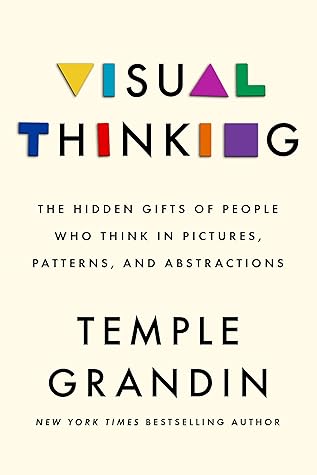More on this book
Community
Kindle Notes & Highlights
Read between
September 1 - September 20, 2024
The first step toward understanding that people think in different ways is understanding that different ways of thinking exist.
visual thinking is not about how we see but about how the brain processes information; how we think and we perceive.
there are object visualizers like me, who think in pictures, and, as I suspected, a second group of mathematically inclined visual-spatial thinkers, an overlooked but essential subset of visual thinkers, who think in patterns.
Think of it this way: the object thinkers build the trains, and the spatial visualizers make them run.
“We don’t make it anymore!” This is the price we have paid for removing most hands-on classes from our schools, such as shop, welding, drafting, and auto mechanics. The kids who should have grown up to invent this equipment are often considered poor performers, academically or behaviorally, and are shunted into special education. But many of them are simply visual thinkers who are being screened out because the current curriculum favors verbal, linear thinkers who are good at taking tests. The hands-on classes where some of these “poor students” might have shown great ability are now gone.
We are losing essential technical skills, for three main reasons. First, the people who had manufacturing expertise are not being replaced at the same rate at which they’re leaving the job market. Second, we’ve ceded the manufacture of not only volume goods such as clothes and toys and appliances to foreign companies but high-tech goods as well (about 30 percent of iPhones are made in China). Last, and this is my main area of focus: we’ve screened out visual thinkers.
It turns out that algebra is a barrier that keeps some students from completing high school or a community college technical degree. These are the visual thinkers who can invent machinery but can’t solve for x, and we are screening them out.
I also want to encourage employers to assess their workforce and to look beyond résumés to see what visual thinkers and neurodiverse people can offer.
Visual thinkers, on the other hand, see images in their mind’s eye that allow them to make rapid-fire associations. Generally, visual thinkers like maps, art, and mazes, and often don’t need directions at all. Some visual thinkers can easily locate a place they’ve been to only once, their internal GPS having logged the visual landmarks. Visual thinkers tend to be late talkers who struggle with school and traditional teaching methods. Algebra is often their undoing, because the concepts are too abstract, with little or nothing concrete to visualize. Visual thinkers tend to be good at arithmetic
...more
“Spatial visualizers” see the world in patterns and abstractions. They are the music and math minds—the statisticians, scientists, electrical engineers, and physicists. You’ll find a lot of these thinkers excel at computer programming because they can see patterns in the computer code. Here’s a way to think of it: The object thinker builds the computer. The spatial thinker writes the code.
One of the most useless questions you can ask a kid is: “What do you want to be when you grow up?” It’s one of those vague verbal-thinker questions. The more useful question is concrete: “What are you good at?” That’s a real starting place to develop interests. Kids need broad exposure to discover their talents. There is no subject I am more passionate about, and the reason is twofold. First, by depriving students of that exposure, we are failing them. And in the process, we are also dismantling the healthy and diverse workforce our country needs.
According to Ellen Ruppel Shell, in a bracing New York Times article, “College May Not Be Worth It Anymore,” the staggering cost of higher education has reached $1.3 trillion in student loans, more than doubling over the course of a decade. She also notes that the 40 percent of people who drop out of college earn just slightly more than high school graduates, barely enough to cover their college debt. She writes, “We appear to be approaching a time when, even for middle-class students, the economic benefit of a college degree will begin to seem dim.” Shell tops it off with an eye-opening
...more
In her bestseller Grit, Angela Duckworth defines grit as a quality that combines both passion and persistence to achieve a long-term goal.
For some adults diagnosed later in life, knowing they are autistic provides long-overdue insight into problems with employment and relationships they have long struggled with.
The good news is that it is becoming more widely known that the talents and skills that people with diverse minds bring to the workplace far outweigh the temporary inconvenience of learning how to reconfigure it for their needs. They are appreciated for their deep knowledge, prolific memory, and attention to detail.
SAP, a large software company, and Hewlett Packard Enterprise have found that people with autism can be highly productive employees if they are given good training and a few accommodations. They may need noise-canceling headphones and a quiet place to work. They may also require more time for training, but after they are trained, they will do really accurate work. At Australia’s Department of Human Services, autistic software testers were 30 percent more productive than their non-autistic counterparts.
A guide for UK employers called Untapped Talent highlights qualities such as attention to detail, high levels of concentration, reliability, excellent memory, and technical ability in people with autism. In addition to quiet working conditions, it mentions sensory breaks, clear work instructions, and changes in lighting as simple accommodations that may be required. And the gifts of such employees aren’t only technical. People with autism are also known to share two other qualities: loyalty and scrupulous honesty.
Managers need to be willing to accept that a neurodiverse individual may have poor interviewing or interpersonal skills.


